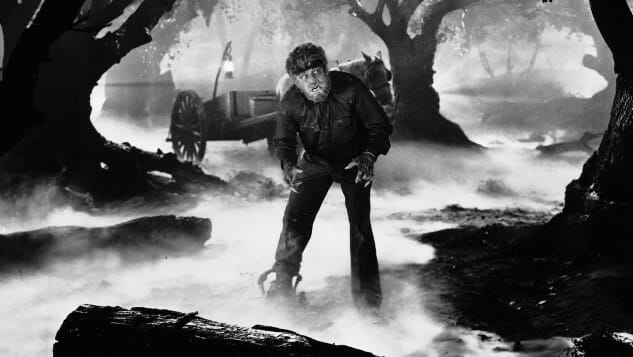
This post is part of Paste’s Century of Terror project, a countdown of the 100 best horror films of the last 100 years, culminating on Halloween. You can see the full list in the master document, which will collect each year’s individual film entry as it is posted.
The Year
More remakes and mad doctors are running rampant in 1941, as Karloff continues to put in work (The Devil Commands), but new faces are arriving on the scene as well. The most notable is the ample frame of Lon Chaney Jr., stepping very neatly into the exact sort of roles once tackled by his father, the Man of a Thousand Faces. His starring turn in The Wolf Man is obviously his most high-profile work in 1941, but he simultaneously appears in Man-Made Monster, and would work steadily in horror for the rest of his life. Due to eventual appearances in the sequels of several franchises in the 1940s, Lon Chaney Jr. holds the distinction of being the only person to portray all four of the major Universal monsters: The Wolf Man, Dracula, The Mummy, and Frankenstein’s Monster.
1941 also gives us a classic comedy fantasy in the form of The Devil and Daniel Webster, which touches on the horror genre thanks to its Faustian elements, along with an early Abbott and Costello feature, Hold That Ghost, which sees the comedy duo inheriting what might be a haunted tavern. It would be seven more years before Abbott and Costello returned to the horror genre for their much better-known rendevouz with Dracula, The Wolf Man and Frankenstein’s Monster, which would serve as an unofficial ending to the era of classic Universal monsters. In 1941, though, we’re still going strong. Not to be forgotten: Alfred Hitchcock’s Suspicion, which isn’t always tagged as a “horror film” per se, but is home to some of the era’s most suspenseful scenes—particularly the bit with Cary Grant fetching his wife a terrifyingly lit glass of what may or may not be poisoned milk.
1941 Honorable Mentions: Dr. Jekyll and Mr. Hyde, Hold That Ghost, The Face Behind the Mask, The Devil and Daniel Webster, Suspicion
The Film: The Wolf Man
Director: George Waggner
After a handful of very successful Frankenstein sequels, but less than ideal follow-ups to Dracula and The Mummy, what the Universal monsters series really needed in 1941 was some fresh blood. This it got, in the form of the fourth head on its monstrous Mount Rushmore: The Wolf Man. In a time when the monster series was beginning to trend toward broader adventure, comedy or self-parody, The Wolf Man brought things nicely back to basics, in a story that favors suspense, atmosphere and character over comedy or overt displays of production value. The Wolf Man’s first priority was scaring cinema-goers, and by all accounts it did just that, despite having to contend against reports from the front lines of World War II.
Universal had already tackled a werewolf yarn six years earlier in Werewolf of London, but where that creature retained a fair amount of his human features, this time the studio went for broke. The stories regarding Jack Pierce’s makeup and the torture it was to apply to star Lon Chaney Jr. are legendary and apocryphal, with the actor at various times stating that it took up to 10 hours to apply, but that may have simply been his desire to live up to his father’s reputation speaking. The results are iconic, although modern audiences likely expect to see a few things in The Wolf Man that aren’t actually present until its sequels. For instance: One never actually sees a facial transformation of Chaney’s Larry Talbot in the original film—nor do we ever see a shot of the full moon. Both of those things are present in the film’s first follow-up, Frankenstein Meets the Wolf Man.
The film is notable for its establishment of Larry Talbot as a particularly pitiable character, by Universal Monster standards. Although this ground had been partially explored by the empathetic Frankenstein’s Monster, who doesn’t understand the world around him, Talbot is actively horrified by the atrocities he commits while rampaging as an unthinking beast, torn between his desire to survive, find a cure and not cause any further harm. As the series goes on, he is repeatedly revived and develops an ultimate goal of finding a permanent death, which is certainly the most nihilistic goal of all the Universal monsters. If the film had come along a few decades later, you’d probably see Wolf Man apparel at Hot Topic.
The production, meanwhile, gets the most out of a reduced budget from the gothic grandeur seen in the likes of Son of Frankenstein, still managing to look like an “A” production for the most part—the last entry in the monster series that can legitimately make that claim. Its forests of gaunt, leaf-stripped trees and fog-wreathed cemeteries still make The Wolf Man seminal Halloween viewing for conjuring that classically spooky vibe. Although none of its sequels can really measure up, and Larry Talbot never receives a stand-alone sequel of his own, it does little to diminish the drum-tight construction of the original.
Jim Vorel is a Paste staff writer and resident horror guru. You can follow him on Twitter for more film and TV writing.